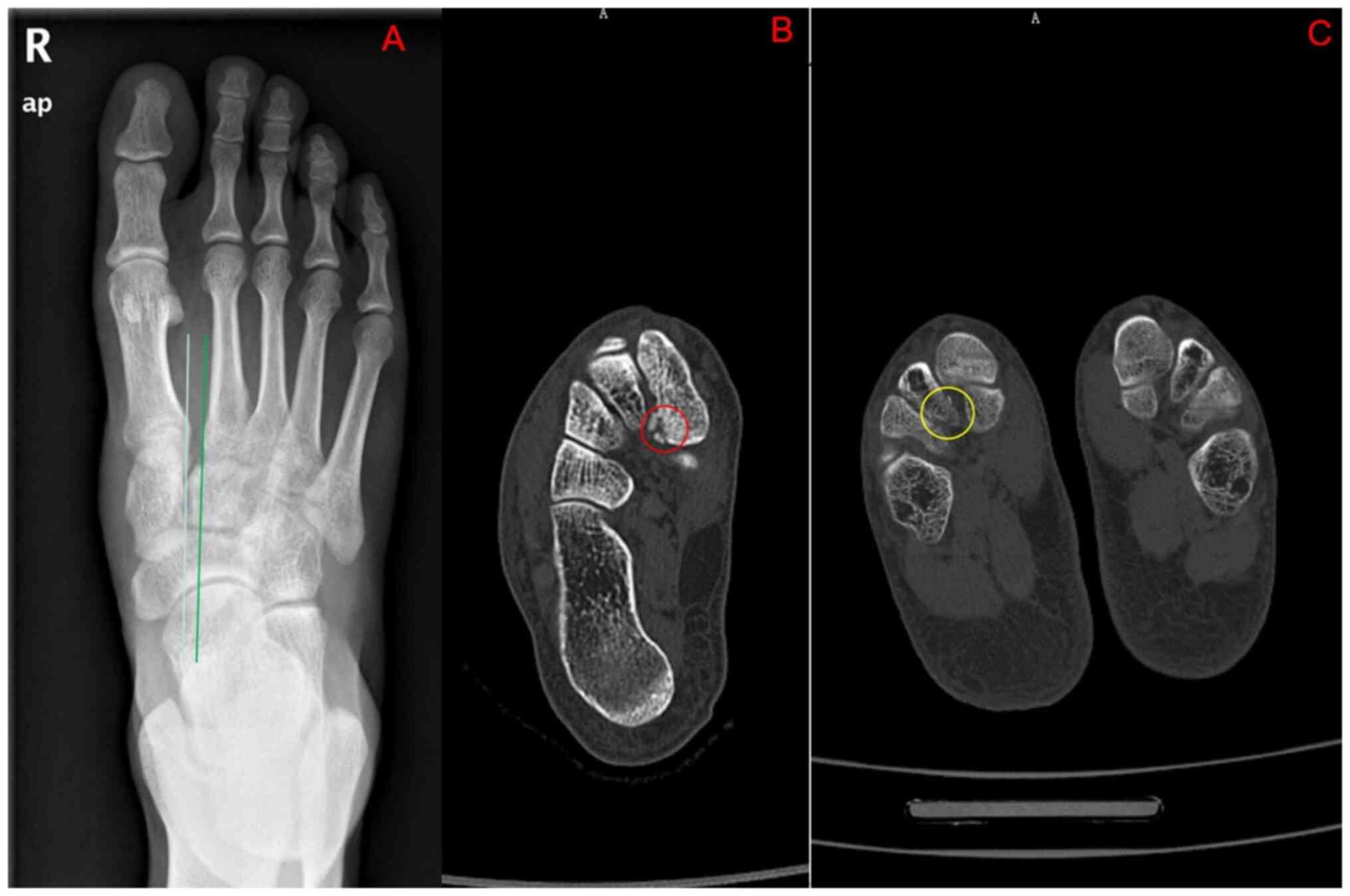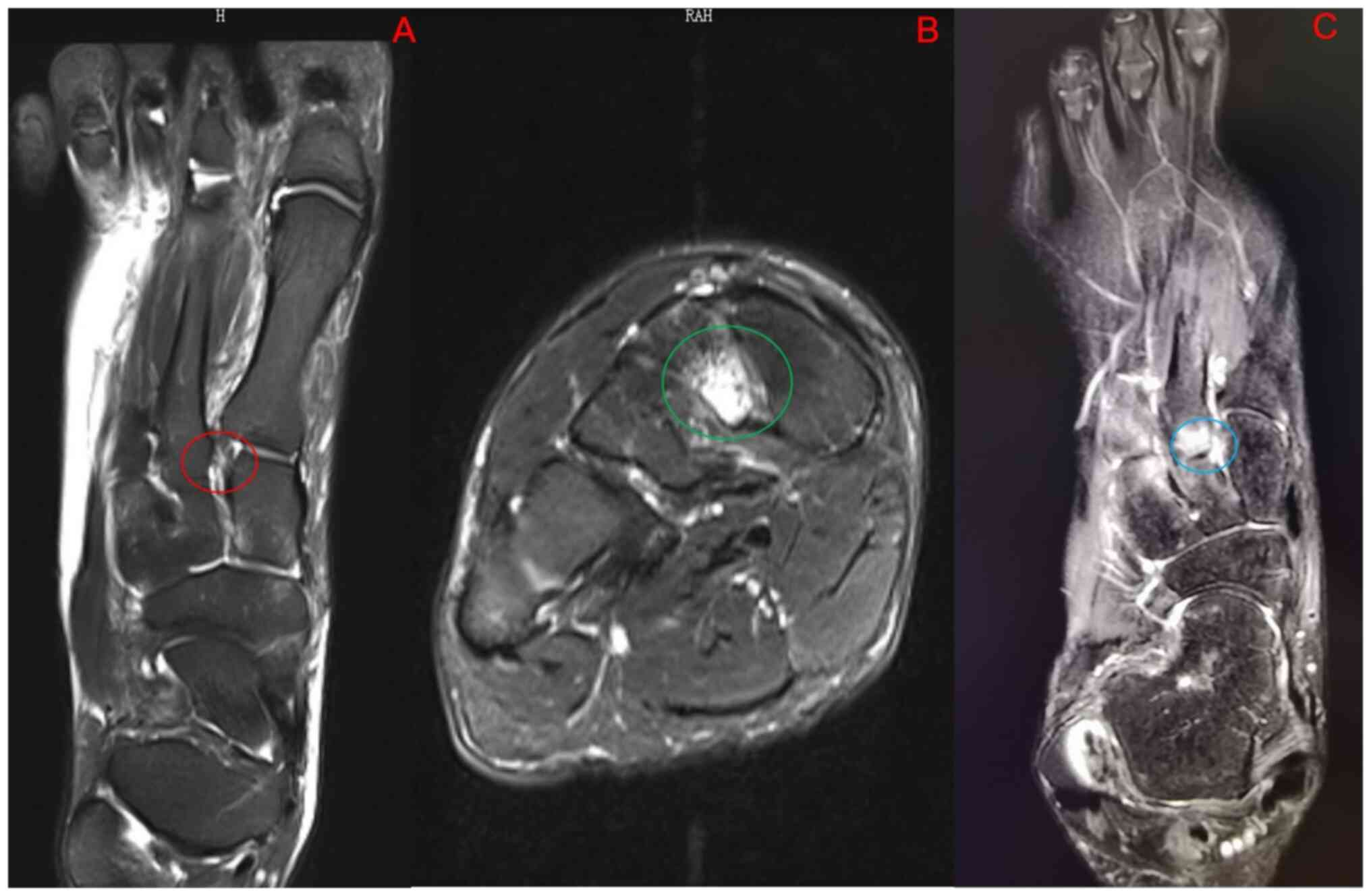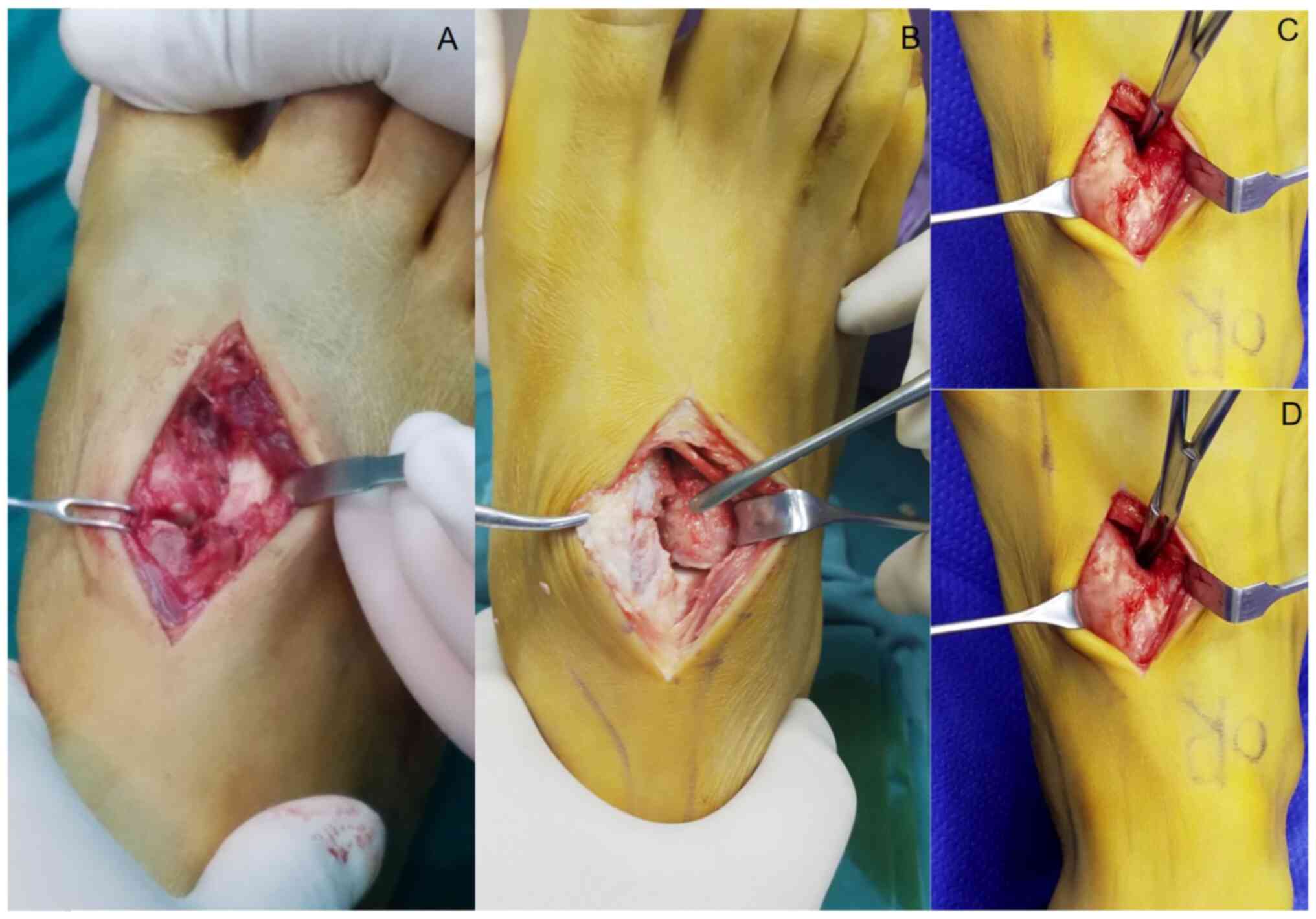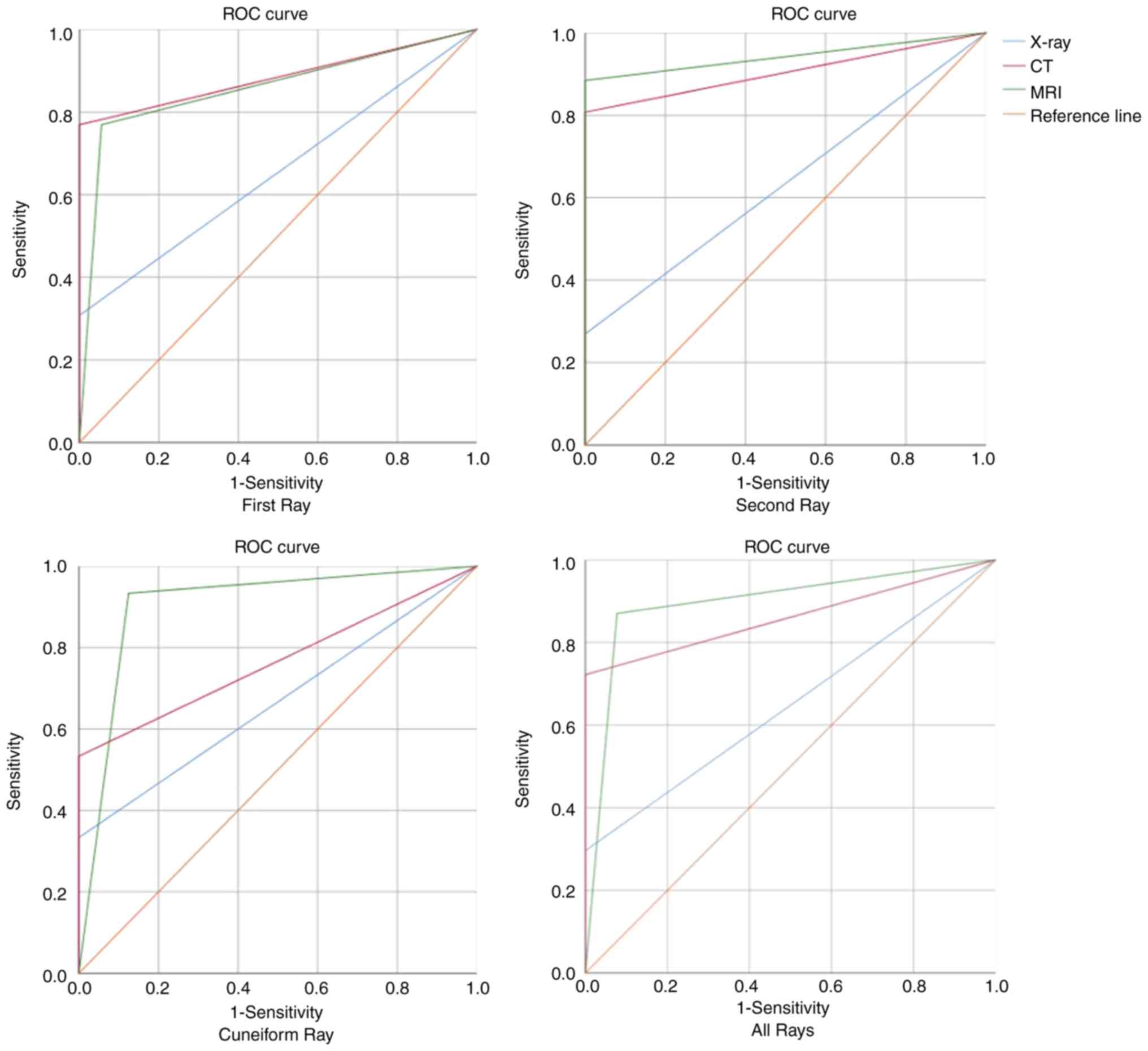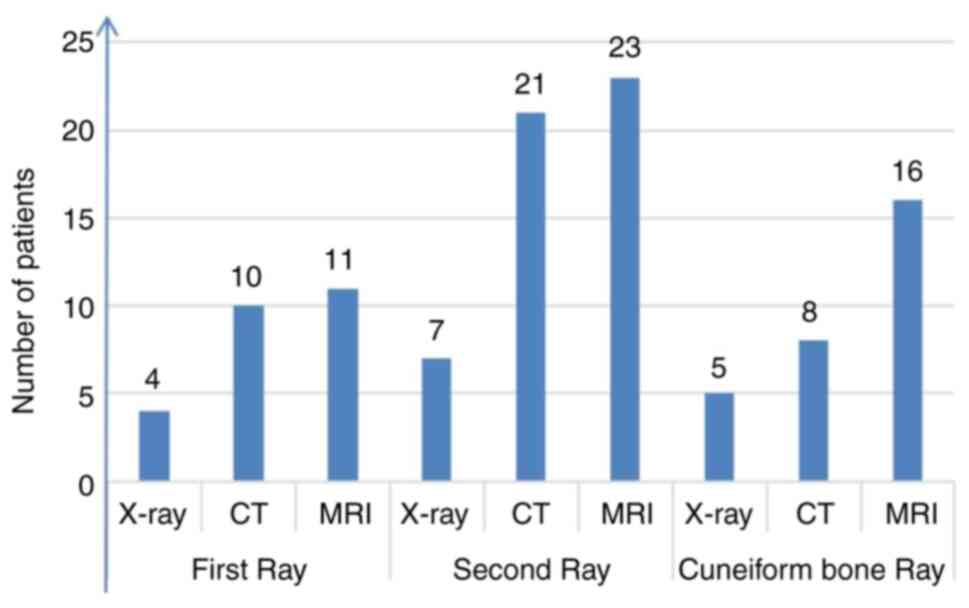|
1
|
Smith N, Stone C and Furey A: Does open
reduction and internal fixation versus primary arthrodesis improve
patient outcomes for lisfranc trauma? A systematic review and
meta-analysis. Clin Orthop Relat Res. 474:1445–1452.
2016.PubMed/NCBI View Article : Google Scholar
|
|
2
|
Renninger CH, Cochran G, Tompane T,
Bellamy J and Kuhn K: Injury characteristics of low-energy lisfranc
injuries compared with high-energy injuries. Foot Ankle Int.
38:964–969. 2017.PubMed/NCBI View Article : Google Scholar
|
|
3
|
Siddiqui NA, Galizia MS, Almusa E and Omar
IM: Evaluation of the tarsometatarsal joint using conventional
radiography, CT, and MR imaging. Radiographics. 34:514–531.
2014.PubMed/NCBI View Article : Google Scholar
|
|
4
|
Sripanich Y, Weinberg MW, Krähenbühl N,
Rungprai C, Saltzman CL and Barg A: Reliability of measurements
assessing the Lisfranc joint using weightbearing computed
tomography imaging. Arch Orthop Trauma Surg. 141:775–781.
2021.PubMed/NCBI View Article : Google Scholar
|
|
5
|
Nunley JA and Vertullo CJ: Classification,
investigation, and management of midfoot sprains: Lisfranc injuries
in the athlete. Am J Sports Med. 30:871–878. 2002.PubMed/NCBI View Article : Google Scholar
|
|
6
|
Briceno J, Leucht A, Younger A and
Veljkovic A: Subtle Lisfranc injuries: Fix it, fuse it, or bridge
it? Foot Ankle Clin. 25:711–726. 2020.PubMed/NCBI View Article : Google Scholar
|
|
7
|
Rosenbaum A, Dellenbaugh S, Dipreta J and
Uhl R: Subtle injuries to the lisfranc joint. Orthopedics.
34:882–887. 2011.PubMed/NCBI View Article : Google Scholar
|
|
8
|
Faciszewski T, Burks RT and Manaster BJ:
Subtle injuries of the Lisfranc joint. J Bone Joint Surg Am.
72:1519–1522. 1990.PubMed/NCBI
|
|
9
|
Norfray JF, Geline RA, Steinberg RI,
Galinski AW and Gilula LA: Subtleties of Lisfranc
fracture-dislocations. AJR Am J Roentgenol. 137:1151–1156.
1981.PubMed/NCBI View Article : Google Scholar
|
|
10
|
Weatherford BM, Anderson JG and Bohay DR:
Management of tarsometatarsal joint injuries. J Am Acad Orthop
Surg. 25:469–479. 2017.PubMed/NCBI View Article : Google Scholar
|
|
11
|
Curtis MJ, Myerson M and Szura B:
Tarsometatarsal joint injuries in the athlete. Am J Sports Med.
21:497–502. 1993.PubMed/NCBI View Article : Google Scholar
|
|
12
|
Kaar S, Femino J and Morag Y: Lisfranc
joint displacement following sequential ligament sectioning. J Bone
Joint Surg Am. 89:2225–2232. 2007.PubMed/NCBI View Article : Google Scholar
|
|
13
|
Seo DK, Lee HS, Lee KW, Lee SK and Kim SB:
Nonweightbearing radiographs in patients with a subtle lisfranc
injury. Foot Ankle Int. 38:1120–1125. 2017.PubMed/NCBI View Article : Google Scholar
|
|
14
|
Kalia V, Fishman EK, Carrino JA and Fayad
LM: Epidemiology, imaging, and treatment of Lisfranc
fracture-dislocations revisited. Skeletal Radiol. 41:129–136.
2012.PubMed/NCBI View Article : Google Scholar
|
|
15
|
Hatch RL, Alsobrook JA and Clugston JR:
Diagnosis and management of metatarsal fractures. Am Fam Physician.
76:817–826. 2007.PubMed/NCBI
|
|
16
|
Desmond EA and Chou LB: Current concepts
review: Lisfranc injuries. Foot Ankle Int. 27:653–660.
2006.PubMed/NCBI View Article : Google Scholar
|
|
17
|
Ly TV and Coetzee JC: Treatment of
primarily ligamentous Lisfranc joint injuries: Primary arthrodesis
compared with open reduction and internal fixation. A prospective,
randomized study. J Bone Joint Surg Am. 88:514–520. 2006.PubMed/NCBI View Article : Google Scholar
|
|
18
|
Sripanich Y, Weinberg MW, Krähenbühl N,
Rungprai C, Mills MK, Saltzman CL and Barg A: Imaging in Lisfranc
injury: A systematic literature review. Skeletal Radiol. 49:31–53.
2020.PubMed/NCBI View Article : Google Scholar
|
|
19
|
Raikin SM, Elias I, Dheer S, Besser MP,
Morrison WB and Zoga AC: Prediction of midfoot instability in the
subtle Lisfranc injury. Comparison of magnetic resonance imaging
with intraoperative findings. J Bone Joint Surg Am. 91:892–899.
2009.PubMed/NCBI View Article : Google Scholar
|
|
20
|
Haraguchi N, Ota K, Ozeki T and Nishizaka
S: Anatomical Pathology of subtle lisfranc injury. Sci Rep.
9(14831)2019.PubMed/NCBI View Article : Google Scholar
|
|
21
|
Yu X, Pang QJ and Yang CC: Functional
outcome of tarsometatarsal joint fracture dislocation managed
according to Myerson classification. Pak J Med Sci. 30:773–777.
2014.PubMed/NCBI
|
|
22
|
Yeoh J, Muir KR, Dissanayake AM and
Tzu-Chieh WY: Lisfranc fracture-dislocation precipitating acute
Charcot arthopathy in a neuropathic diabetic foot: A case report.
Cases J. 1(290)2008.PubMed/NCBI View Article : Google Scholar
|
|
23
|
Ponkilainen VT, Laine HJ, Mäenpää HM,
Mattila VM and Haapasalo HH: Incidence and characteristics of
midfoot injuries. Foot Ankle Int. 40:105–112. 2019.PubMed/NCBI View Article : Google Scholar
|
|
24
|
Singh A, Lokikere N, Saraogi A,
Unnikrishnan PN and Davenport J: Missed Lisfranc injuries-surgical
vs conservative treatment. Ir J Med Sci. 190:653–656.
2021.PubMed/NCBI View Article : Google Scholar
|
|
25
|
Haapamaki V, Kiuru M and Koskinen S:
Lisfranc fracture-dislocation in patients with multiple trauma:
Diagnosis with multidetector computed tomography. Foot Ankle Int.
25:614–619. 2004.PubMed/NCBI View Article : Google Scholar
|
|
26
|
Preidler KW, Peicha G, Lajtai G, Seibert
FJ, Fock C, Szolar DM and Raith H: Conventional radiography, CT,
and MR imaging in patients with hyperflexion injuries of the foot:
Diagnostic accuracy in the detection of bony and ligamentous
changes. AJR Am J Roentgenol. 173:1673–1677. 1999.PubMed/NCBI View Article : Google Scholar
|
|
27
|
Castro M, Melão L, Canella C, Weber M,
Negrão P, Trudell D and Resnick D: Lisfranc joint ligamentous
complex: MRI with anatomic correlation in cadavers. AJR Am J
Roentgenol. 195:W447–W455. 2010.PubMed/NCBI View Article : Google Scholar
|
|
28
|
Sands A and Grose A: Lisfranc injuries.
Injury. 35 (Suppl 2):SB71–SB76. 2004.PubMed/NCBI View Article : Google Scholar
|
|
29
|
Arntz CT, Veith RG and Hansen ST Jr:
Fractures and fracture-dislocations of the tarsometatarsal joint. J
Bone Joint Surg Am. 70:173–181. 1988.PubMed/NCBI
|
|
30
|
Sherief TI, Mucci B and Greiss M: Lisfranc
injury: How frequently does it get missed? And how can we improve?
Injury. 38:856–860. 2007.PubMed/NCBI View Article : Google Scholar
|
|
31
|
Stein RE: Radiological aspects of the
tarsometatarsal joints. Foot Ankle. 3:286–289. 1983.PubMed/NCBI View Article : Google Scholar
|
|
32
|
Llopis E, Carrascoso J, Iriarte I, Serrano
Mde P and Cerezal L: Lisfranc injury imaging and surgical
management. Semin Musculoskelet Radiol. 20:139–153. 2016.PubMed/NCBI View Article : Google Scholar
|
|
33
|
Ponkilainen VT, Partio N, Salonen EE,
Riuttanen A, Luoma EL, Kask G, Laine HJ, Mäenpää H, Päiväniemi O,
Mattila VM and Haapasalo HH: Inter- and intraobserver reliability
of non-weight-bearing foot radiographs compared with CT in Lisfranc
injuries. Arch Orthop Trauma Surg. 140:1423–1429. 2020.PubMed/NCBI View Article : Google Scholar
|
|
34
|
Wong LH, Chrea B, Atwater LC and Meeker
JE: The first tarsometatarsal joint in Lisfranc injuries. Foot
Ankle Int. 43:1308–1316. 2022.PubMed/NCBI View Article : Google Scholar
|
|
35
|
Kennelly H, Klaassen K, Heitman D,
Youngberg R and Platt SR: Utility of weight-bearing radiographs
compared to computed tomography scan for the diagnosis of subtle
Lisfranc injuries in the emergency setting. Emerg Med Australas.
31:741–744. 2019.PubMed/NCBI View Article : Google Scholar
|
|
36
|
Hatem SF: Imaging of lisfranc injury and
midfoot sprain. Radiol Clin North Am. 46:1045–1060, vi.
2008.PubMed/NCBI View Article : Google Scholar
|
|
37
|
Lewis JS Jr and Anderson RB: Lisfranc
injuries in the athlete. Foot Ankle Int. 37:1374–1380.
2016.PubMed/NCBI View Article : Google Scholar
|















